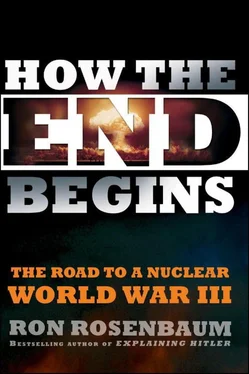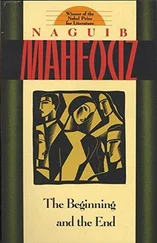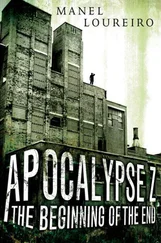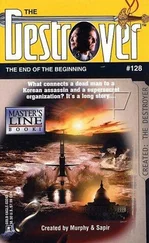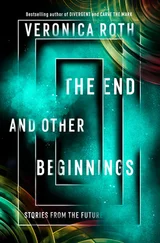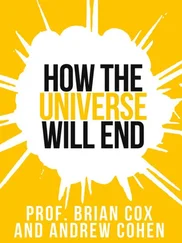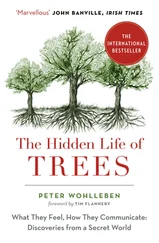This new thinking involved everything from a range of new weapons to new strategies. It was obsessed with developing and deploying still unproven ballistic missile defense weapons and with the creation and use of smaller tactical nuclear weapons, even mini-nukes that would purportedly be ideal to deploy against hard and deeply buried targets or HDBTs. The mini-nukes were given the suggestive nuke porn name Robust Nuclear Earth Penetrators.
Few facts have been gleaned about the new master nuclear targeting plan, once called “the most secret document in the world.” But one part of it has been declassified in response to a FOIA request by Hans M. Kristensen of the Federation of American Scientists. [53]Almost all the pages are marked top secret and are blacked out. But two blacked-out pages include titles that make clear that “regional states” (that is, nations in troubled regions who are close to going nuclear) have been included in the master nuclear target base list. According to Kristensen this means American doctrine now contemplates nuclear first strikes against them, where nuclear strikes were once restricted to nuclear powers. [54]Could it be that this partial declassification was designed to draw attention to this new policy development? Was it our intention to let these regional states know we have first-strike targeting plans against them, buried somewhere in the software of the president’s nuclear football?
The U.S. had long resisted the pressure by the anti-nuke elements of the international community, and some arms control specialists, to renounce the first use of nuclear weapons. We had adopted a policy of deliberate ambiguity, which in effect was an affirmation of the willingness to be the first to use nuclear weapons in an escalating conflict. During the Cold War we refused to refuse first use largely because of the desire by our NATO allies in Western Europe to feel they had a U.S. nuclear umbrella as protection against the Soviet Union and its Warsaw Pact allies. To the question of whether we’d be prepared to use nukes to stop an East Bloc advance and risk an almost certain nuclear attack on the U.S. in response—to fight the resulting global nuclear war to protect Alsace-Lorraine, in effect—we wouldn’t say “no first use.” (We wouldn’t say whether we would use nukes to deter North Korea from attacking South Korea either.) Our policy was ambiguity.
Most Cold War historians regard our nuclear ambiguity over first use as especially important in preventing a conventional war from breaking out in Europe during the Cold War. Soviet conventional forces outweighed NATO’s and the U.S. refusal to discount the option of going nuclear first—to stop the Soviets if they seemed to be breaking through Western lines—may well have checkmated that possibility, again at the risk of incinerating Europe to save it.
Still the concept of first use is different from first strike. The former is usually used in the context of defense and deterrence—a threat to deter a conventional war. The latter—first strike—is purely an offensive context, a preemptive nuclear strike, a surprise attack.
But first use, first strike preemptive nuclear war has developed a second life among the new Strangeloves, and some of the foremost old Cold Warriors.
On January 22, 2008, the U.K. Guardian shook readers with a report on a manifesto issued by former NATO commanders including General John Shalikashvili from the U.S., Lord Inge from the U.K., and Klaus Naumann from Germany. Under the headline “PRE-EMPTIVE NUCLEAR STRIKE A KEY OPTION, NATO TOLD,” defense reporter Ian Traynor wrote: “The west must be ready to resort to a pre-emptive nuclear attack to try to halt the ‘imminent’ spread of nuclear and other weapons of mass destruction, according to a radical manifesto for a new NATO by five of the west’s most senior military officers and strategists.”
They were trying to shock complacent NATO governments into realizing that we had entered a new age of nuclear war and the rules needed to be changed. They argued that nukes must be brought to the fore again, contrary to NATO’s trend toward de-emphasizing nuclear weapons. The only possibility of peace is rule by an iron hand, enforced by plutonium.
MAD is dead or no longer the certain deterrent it was in the bipolar Cold War. The rise of the ideology of suicidal martyrdom—even national suicidal martyrdom (say, Iran sacrificing itself to destroy Israel)—means deterrence can no longer actually deter “rogue states” and “nonstate actors” who are too fanatic to be concerned with retaliatory consequences or who can detonate a deadly “bomb with no return address” that cannot be traced to its origin and so makes MAD’s threat of retaliation an empty one. According to these first strike manifesto generals, we should retain the ability to preempt a nuclear or near-nuclear power: Shoot first and ask questions later.
First on their list of threats that must be countered by nukes was proliferation by rogue states. The “risk of further nuclear proliferation is imminent and, with it, the danger that nuclear war fighting limited in scope might become possible,” the manifesto said. For that reason, they said, “The first use of nuclear weapons must remain in the quiver of escalation as the ultimate instrument to prevent the use of weapons of mass destruction.” [55]
These are men, the first-use manifesto signers, who spent years with their fingers on the trigger. Their perception of what they called “an increasingly brutal world” is hard to argue with. And yet it’s not a world that is as close—a shot away—from global nuclear war at any moment as it was during the Cold War, is it? Wasn’t the prevention of global nuclear war an achievement—no small one—of no-first-strike MAD deterrence? Or—the recurrent question—was it just blind luck?
Whichever it was, the implications of the first strike manifesto were not lost on those paying attention. Suddenly, as Elbridge Colby, who served recently in the Office of the Director of National Intelligence, and has recently been engaged in the renegotiation of the START treaty, told me, it looks as if deterrence is under attack by critics “from left and right.” [56]Both groups are arguing that things are no longer simple the way they were during the bipolar balance of terror. The risks are multiple, asymmetrical, not susceptible to the binary logic of deterrence.
Why suddenly the first strike leap in the former NATO chiefs’ manifesto? For one thing it’s not as sudden as it seems. It represents the tip of the iceberg of a decade of think tank and military strategic revaluation of the post–Cold War, post–balance of terror use of our nuclear arsenal. And that attack on deterrence or passive defense has led to the rise of the movement for active Ballistic Missile Defense of the sort that led the Bush administration to pledge in 2007 to install ballistic missile interceptors in Poland and which may have been the real source of the spike in tensions between the U.S. and Russia that began with the strategic flights and broke out over the invasion of Georgia. Despite its name, Ballistic Missile Defense is considered a first strike offensive, not primarily a defensive, capability. It permits an offensive first strike to be carried out with less fear of a successful retaliation (assuming the so far unproven BMD technology actually works).
The Year of Living Dangerously Again may have been as much the product of the shortsighted, think tank, new-Strangelove nuclear strategy reflected in the first strike manifesto, as much as the result of Putin’s empire building. But such manifestos are responding to something real and new in this second nuclear age: the loss in confidence in nuclear deterrence, in the stability that MAD once offered. To some, MAD is dead and we are the worse for it in the unstable situation it leaves behind.
Читать дальше
